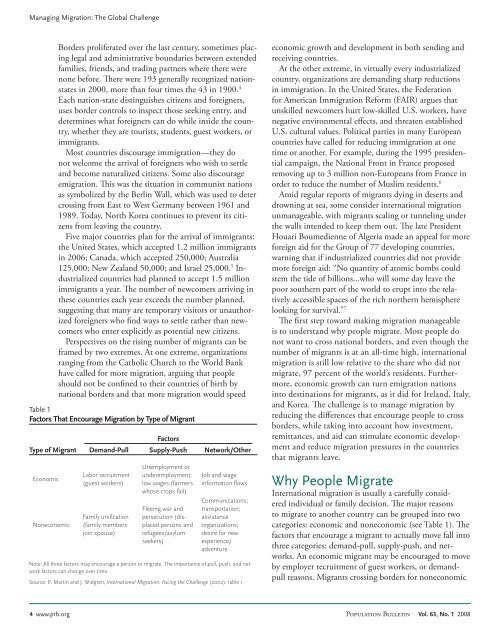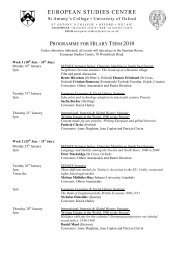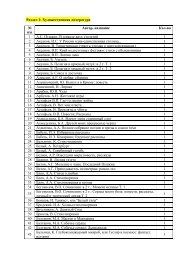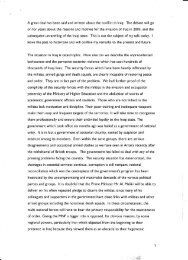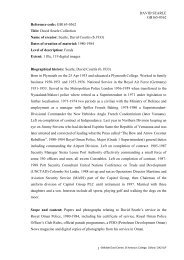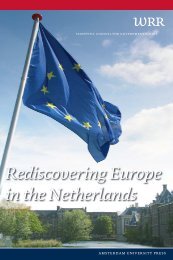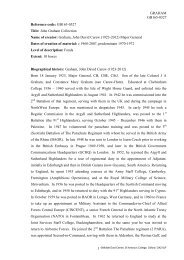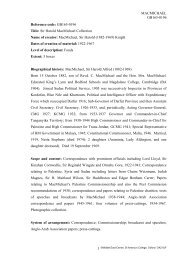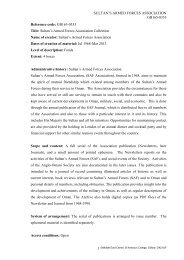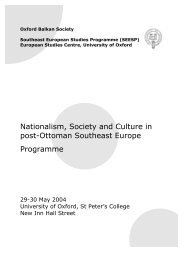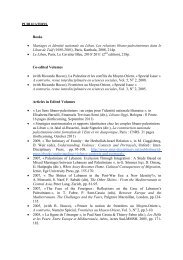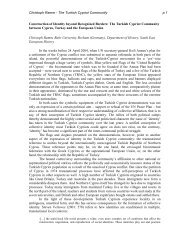Managing Migration: The Global Challenge, Population Bulletin, Vol ...
Managing Migration: The Global Challenge, Population Bulletin, Vol ...
Managing Migration: The Global Challenge, Population Bulletin, Vol ...
You also want an ePaper? Increase the reach of your titles
YUMPU automatically turns print PDFs into web optimized ePapers that Google loves.
<strong>Managing</strong> <strong>Migration</strong>: <strong>The</strong> <strong>Global</strong> <strong>Challenge</strong><br />
Borders proliferated over the last century, sometimes placing<br />
legal and administrative boundaries between extended<br />
families, friends, and trading partners where there were<br />
none before. <strong>The</strong>re were 193 generally recognized nationstates<br />
in 2000, more than four times the 43 in 1900. 4<br />
Each nation-state distinguishes citizens and foreigners,<br />
uses border controls to inspect those seeking entry, and<br />
determines what foreigners can do while inside the country,<br />
whether they are tourists, students, guest workers, or<br />
immigrants.<br />
Most countries discourage immigration—they do<br />
not welcome the arrival of foreigners who wish to settle<br />
and become naturalized citizens. Some also discourage<br />
emigration. This was the situation in communist nations<br />
as symbolized by the Berlin Wall, which was used to deter<br />
crossing from East to West Germany between 1961 and<br />
1989. Today, North Korea continues to prevent its citizens<br />
from leaving the country.<br />
Five major countries plan for the arrival of immigrants:<br />
the United States, which accepted 1.2 million immigrants<br />
in 2006; Canada, which accepted 250,000; Australia<br />
125,000; New Zealand 50,000; and Israel 25,000. 5 Industrialized<br />
countries had planned to accept 1.5 million<br />
immigrants a year. <strong>The</strong> number of newcomers arriving in<br />
these countries each year exceeds the number planned,<br />
suggesting that many are temporary visitors or unauthorized<br />
foreigners who find ways to settle rather than newcomers<br />
who enter explicitly as potential new citizens.<br />
Perspectives on the rising number of migrants can be<br />
framed by two extremes. At one extreme, organizations<br />
ranging from the Catholic Church to the World Bank<br />
have called for more migration, arguing that people<br />
should not be confined to their countries of birth by<br />
national borders and that more migration would speed<br />
Table 1<br />
Factors That Encourage <strong>Migration</strong> by Type of Migrant<br />
Type of Migrant Demand-Pull Supply-Push Network/Other<br />
Economic<br />
Noneconomic<br />
Labor recruitment<br />
(guest workers)<br />
Family unification<br />
(family members<br />
join spouse)<br />
Factors<br />
Unemployment or<br />
underemployment;<br />
low wages (farmers<br />
whose crops fail)<br />
Fleeing war and<br />
persecution (displaced<br />
persons and<br />
refugees/asylum<br />
seekers)<br />
Job and wage<br />
information flows<br />
Communications;<br />
transportation;<br />
assistance<br />
organizations;<br />
desire for new<br />
experience/<br />
adventure<br />
Note: All three factors may encourage a person to migrate. <strong>The</strong> importance of pull, push, and network<br />
factors can change over time.<br />
Source: P. Martin and J. Widgren, International <strong>Migration</strong>: Facing the <strong>Challenge</strong> (2002): table 1.<br />
economic growth and development in both sending and<br />
receiving countries.<br />
At the other extreme, in virtually every industrialized<br />
country, organizations are demanding sharp reductions<br />
in immigration. In the United States, the Federation<br />
for American Immigration Reform (FAIR) argues that<br />
unskilled newcomers hurt low-skilled U.S. workers, have<br />
negative environmental effects, and threaten established<br />
U.S. cultural values. Political parties in many European<br />
countries have called for reducing immigration at one<br />
time or another. For example, during the 1995 presidential<br />
campaign, the National Front in France proposed<br />
removing up to 3 million non-Europeans from France in<br />
order to reduce the number of Muslim residents. 6<br />
Amid regular reports of migrants dying in deserts and<br />
drowning at sea, some consider international migration<br />
unmanageable, with migrants scaling or tunneling under<br />
the walls intended to keep them out. <strong>The</strong> late President<br />
Houari Boumedienne of Algeria made an appeal for more<br />
foreign aid for the Group of 77 developing countries,<br />
warning that if industrialized countries did not provide<br />
more foreign aid: “No quantity of atomic bombs could<br />
stem the tide of billions...who will some day leave the<br />
poor southern part of the world to erupt into the relatively<br />
accessible spaces of the rich northern hemisphere<br />
looking for survival.” 7<br />
<strong>The</strong> first step toward making migration manageable<br />
is to understand why people migrate. Most people do<br />
not want to cross national borders, and even though the<br />
number of migrants is at an all-time high, international<br />
migration is still low relative to the share who did not<br />
migrate, 97 percent of the world’s residents. Furthermore,<br />
economic growth can turn emigration nations<br />
into destinations for migrants, as it did for Ireland, Italy,<br />
and Korea. <strong>The</strong> challenge is to manage migration by<br />
reducing the differences that encourage people to cross<br />
borders, while taking into account how investment,<br />
remittances, and aid can stimulate economic development<br />
and reduce migration pressures in the countries<br />
that migrants leave.<br />
Why People Migrate<br />
International migration is usually a carefully considered<br />
individual or family decision. <strong>The</strong> major reasons<br />
to migrate to another country can be grouped into two<br />
categories: economic and noneconomic (see Table 1). <strong>The</strong><br />
factors that encourage a migrant to actually move fall into<br />
three categories: demand-pull, supply-push, and networks.<br />
An economic migrant may be encouraged to move<br />
by employer recruitment of guest workers, or demandpull<br />
reasons. Migrants crossing borders for noneconomic<br />
4 www.prb.org <strong>Population</strong> <strong>Bulletin</strong> <strong>Vol</strong>. 63, No. 1 2008


